August 30, 2011
Marine Surplus Inc, Fort Myers
We left early in the morning to head down to Marine Surplus Inc in Fort Myers, FL. Our primary mission for the day is to check out fuel tanks, but we also want to scout for other needed items on the list and check prices.
When we arrived, we went right out to the back yard where they have various sizes of plastic and aluminum fuel tanks for boats. Some are strangely shaped, and are clearly intended for one specific spot in one model of boat, while others are fairly standard shapes. Our interest was in 80 gallon plastic tanks made by Moeller. Measurements indicated that they would fit the boats, but we wanted to have a look at them in person. We also wanted to see whether they might just happen to have some oddball tanks that we did not know about, but that would suit the application better.
The previously installed aluminum tanks were 135 gallons each, and we both agree that 80 gallons is on the low end of the capacity range for a boat of this size. On the other hand, the boats burn about 35 gallons in a typical week on the Silver Bank, so while 80 is a bit small for the boats, it is plenty for the intended application. If the boats ever need to have extended range, they will have to do what a lot of island-hopping small powerboats do: secure a drum of fuel on deck for those trips.
While Gene checked out the tanks, I wandered around to see what other kinds of things were out in the back yard. They had some console grab rails, stainless steel bow rails, aluminum poling platforms for flats boats, and aluminum T-Top frames for center console fishing boats.
Back inside the front room of the store, they have quite a collection of deck plates and access hatches. They also had small boat consoles, lockable dock boxes, and a few more fuel tanks in this area. I was already starting to get that "kid in a candy store" feeling, and we had just begun to explore the smaller of the two marine liquidation warehouses on the day's agenda!

I took a picture of this thing just because I could not figure out what it was. It was in a corner with a bunch of small cabin doors in frames, and is obviously some kind of a hatch or door, but what kind? It has an aluminum lipped frame with a hinged door in it, then there is a piece of starboard mounted on top on some sliding hinges, apparently so that it can lay flat or stick out perpendicular to the door part. The various cutouts and the curved up edge of the aluminum lip tell me that this piece is intended to go in one particular place on one kind of boat, but that is about all I could figure out.
One of the things I like about places like this one is the variety of items on sale. Next to the engine exhaust risers for common OMC and Mercruiser engines, we have small opening ports of various sizes. Of course those two things go together! They are both for boats!

In a large back room, they have "Prop Land" over beyond the giant spool of 1.5 inch manila rope, with a variety of new, used, and reconditioned propellers on sale. The surrounding area included end caps with Volvo Penta belts and pulleys, impellers, trailer guide on posts, and a box of Baltek structural balsa core material. I found it ironic that there is a small water stain on the end of the Baltek box. Recalling my experience removing rotten balsa soup from the deck of my Corsair F-27, I thought the water intrustion looked like a taste of things to come. Balsa makes a great core material, very light and strong, but the stories of problems with water are endless.
Along one wall of that room, there was a large rack built to hold two rows of Bimini tops. The owner explained to me that inventory is a bit low because an order is due in soon, but there are still a dozen or so Bimini tops with stainless steel or aluminum frames. The pipes in the foreground contain tubing for those who like to bend and build their own Bimini tops.
Opposite the Bimini top rack is an end cap with all kinds of bilge pump fittings, through hull fitting strainers and screens, Rabud Sea Scupper ball type one-way scupper valves, and bait well accessories. This is just a sampling of things to be found in this store, but there was much more. A wall full of steering wheels and throttles, a room of electrical switches, cords, and wires, a small room filled with fiberglass and supplies, and pretty much anything else that goes on a boat can probably be found here.

Marine Connection Liquidators in Fort Pierce
When we arrived in the parking lot at Marine Connection Liquidators in Fort Pierce, this was the view out in front of the truck. They have a few extra stainless steel bow rails and aluminum frames for boat tops, it seems. It turned out that these are only the very large bow rails, and the real collection is inside. My guess is that things outside the fence are simply too large to steal and not valuable enough to overcome that problem.
This is a big building. You can not see to the end of it in this photo, taken outside the front door. Out front are some fish cleaning tables and dock boxes, some large boat center consoles with T-tops, a couple of used boat trailers and an old Robalo fishing boat. There were also three boxes lined up with $10.00 spray painted across the sides of them. I had to learn what was in those boxes for ten bucks, and the answer was: boat cushions! Just random boat cushions of all different sizes and shapes, all of them looking like they belong in the trash, not on display for sale. I guess people buy them to get the foam.

Taken from about the same position, this shot shows a bit more of the things out in front of the Marine Connection Liquidators warehouse. There is a double axle and triple axle trailer in the foreground, but those consoles caught my eye. Those are obviously brand new center consoles with aluminum T-tops from some pretty good sized boats, but they have never been cut for steering system or controls installation. Some of these may be generic new consoles, not made for a particular boat, but some appear to be custom jobs that were built to go on a certain boat, but the builder went out of business.
![]()
I walked over and took a closer shot over the fence. Aluminum fuel tanks piled to the sky on large racks, and every rack is surrounded by stacks of bow rails of various sizes. Fiberglass consoles for small boats, leaning posts, large cooler seats and more and more fuel tanks. It becomes increasingly apparent as you walk around this place that the disasters never end in the boat building business. One horrible thought that struck me as I looked at all of this stuff: there is no way they could secure this place for a real hurricane. All of this stuff would be spread all the way to Lake Okeechobee.

Walking around inside the fence, there are a lot of smaller items laying around amongst the fuel tanks and bow rails that occupy most of the space. Gene was interested in these rubber mats to use as liners underneath the new fuel tanks. Also shown: a pallet of rudders, aluminum flybridge ladders, dock ladders, and aluminum railings. Behind us on the back fuel tank rack were stacked sheets of Starboard marine lumber.
Leaning against a rack of fuel tanks were these two really nice aluminum davits. This kind of thing must be quite a challenge in the liquidation business. They are neat, but who will want them, and how will that person know they are here? Also shown is an old galvanized davit of the type that hangs on a piling to lift small skiffs. That is an easier sale. Lots of people have pilings and small boats to pick up, but who has an application that requires smallish aluminum davits?

Inside the store, Marine Connection Liquidators is an interesting blend of a normal boating store and a boat builder's warehouse. Just inside the door is a 55 gallon drum full to the brim with stainless screws, nuts, and bolts of all sizes, being sold by the pound. The price was $4.95/lb unless you want 5 pounds or more, in which case the price drops to $3.95/lb. In the picture at right, looking toward the desk and front door, you can see trolling motors, sportsfishing fighting chairs, compasses in a glass case, and a rack with rolls of fiberglass. There are also rolls of uphostery fabric, padded non-skid deck mats, and big, bronze propellers on the wall.
On this aisle, it looks as if Gene is shopping at an ordinary marine store, as long as you ignore what is up high. He is examining the selection of fuel filters, deck fill fittings, hoses, and portable tanks. Behind him are Shakespeare VHF antennas and in the background are sportswear shirts. My impression is that it's a normal store below about 8 feet, and above that level, anything could be warehoused in boxes, not necessarily related to the stuff below. How they keep track of all this stuff is beyond me.

The dive gear corner of the store provides another example of what I am talking about. They have masks, snorkels, fins, gloves, BC's, regulators, tanks, and even a couple of little dive scooters. All pretty normal stuff that one would see in a dive store, or the diving section of a marine store, but look up. There are rows of Yamaha, Mercury, and Evinrude outboard motor covers. Not your ordinary dive store offerings! The thing I love about this place is, no matter which unrelated things they put next to one another, they are ALL related to me because I love all boats!
The end of one aisle is occupied by boat manufacturer decals from many different brands, including Wellcraft, Boston Whaler, Cobia, Aquasport, Twin Vee and others. They even have the model decals, special tournament edition decals, and others if you are willing to dig a little.

Our first mission was to check out the fuel tanks, but I had to stop and take a shot down this aisle on the way. They have Bimini tops in every size and color imaginable on large racks on one side and anchors on the opposite side. There were a normal assortment of small Danforth and Bruce type anchors in galvanized and stainless steel, and also several large boat anchors, including one big Bullwagga. A bit further down the row you can see the foam for boat cushions and the raw wood selection, which had some beautiful large pieces of mahogany and enough teak trim to fill a pickup truck bed.
All of the aluminum fuel tanks live outside, but the whole back wall of the outside warehouse area is a giant rack filled with plastic boat fuel tanks of almost every size and shape imaginable. All except the particular size and shape that will work in Gene's boats. Those are back in Fort Myers.

The floor underneath this rack was completely stuffed with small boat console windshields in various sizes. Above were tackle stations, glove boxes, and other small lockers made for flush mounting.
This rack housed an impressive pile of elliptical and oval opening port windows in various sizes and styles, including metal and plastic framed ones. I could see several piles of matching portlights with screens in the pile, but it looked like a great place to search for that one you can't seem to find anywhere else.

The consoles on Gene's boats have a "glove box" storage space underneath the control panel, separated from the battery compartment below by a shelf. Both of these had the original doors on them, and both were showing their age. On the aisle containing all the deck plates, watertight access hatch doors, and small doors in frames, we found the perfect replacements, shown in the picture at right. My thought had been that we could recreate the original doors, but if we could find replacements for $40 or less, it would be worth just buying new doors to avoid the time and expense of making them over again. The price on these was $39.95, making it in under the wire.
While Gene was comparing prices on the usual assortment of marine grade wiring, I was interested to see an alternative way to buy it at a surplus place like this one: tinned copper marine grade wire by the pound! You can not see it in the photo, but the sign on that giant crate behind Gene says that the wire inside is available for $5 per pound, your choice of pieces. Most of it appears to be new, or possibly installed once and then ripped right back out of a boat, and there are just coils of various sizes of wiring in various lengths. If you come knowing exactly what you want, this could be a place to find a bargain on tinned copper wiring! In front of Gene and mostly cut out of the picture are two large crates full of made up cables with ends on them. We were sure that the battery cables he will be needing must be already made up in those crates, if only we knew exactly what would be needed. We do not yet have that information.

If we can not find the pre-made battery cables we need in those two big crates inside, it's a pretty sure bet they are in these giant crates, boxes, and barrels out in the outside warehouse. Not as certain is whether it would be worth the time required to find what you need if it happens to be back on the bottom of one of those crates. There are also spools of wire that are too depleted for the indoor display area, but still have a potentially useful amount of wire on them.
While Gene was looking at the wire choices, I wandered into the nearby electronics aisle, where among the offerings were some boxes and shelves that were just filled with various old depth finders, radar display units, and other navigation electronics of various types and ages. I saw the corner of one sticking out from under the rest, and the colors and positions of the few buttons I could see were very familiar to me. Could it be? I pulled it out, and sure enough, I had found an old friend. This is a Northstar 800 LORAN, and I recognized it because I owned one back in 1988, when it was considered a state of the art unit. I had spent many hours staring at it, and apparently the look was well burned into my memory. When I pulled it out and saw what it was, the first thing I wondered was, "Why is this not in the trash?"
Interesting that our modern electronic navigation aids have such a short lifespan. There are plenty of old sextants out there dating back a hundred years or more, and people still actually use sextants much older than this Northstar 800 for navigation, yet in less than a quarter century the Northstar has gone from the coolest thing we had ever seen to being a candidate for a landfill.

Out in the back warehouse were these large bins filled with scraps of plastic marine lumber, often sold under the trade name King Starboard, so everyone just calls all of it "starboard" whether or not that is technically correct. This stuff is both expensive and heavy to buy by the sheet, especially if all you need is a small piece. Along the wall in the background are boarding ladders of various types. They have some of the kind that just hang over the gunwale, and quite a few of the telescoping ladders made for mounting on swim steps or dive platforms. There are also some closed cell foam cushions made to fit the forward decks of small boats. I was looking at those to pad the bow area on our 15' Whaler.
As long as I was near one of the loading dock doors, I decided to take a peek out back and see what was behind the warehouse. I am not sure what I expected to see, but it was not what you see in the picture at left. They have almost as much stuff just sitting around in the yard as they have in the building! A row of windshields, a field of welded aluminum structures, and a raft of boat cushions were among the prominent features. In the distance are even more boat fuel tanks.

This rack end cap was filled from floor to ceiling with marine refrigerators and ice makers of various sizes. What I'm not so sure about is the roll up rope ladder in the picture. Is that an item for sale, or is that how they get to the fridges up top? It looks like something that belongs in the nautical decor department, but also looks like they might actually use it.
![]()
If that area does not yield the refrigerator you want, there are also a few more 12 volt marine refrigeration units over with the compact microwave ovens and inboard engine transmissions. It's not every marine store that has a section devoted to microwaves and transmissions. In fact, this is my first, but I have to say I like it!

This rack contains bins of used two stroke outboard oil injection tanks for OMC and Mercury engines, exhaust mufflers and risers/mixing elbows for inboard diesels, and tackle station boxes. Parts is parts.
![]()
It is interesting to see what gets shoved off into the back corner of a place like this one. In addition to the rolls and rolls of fiberglass, there are stacks of boarding steps of the type that boat dealerships use to access display boats, a rack of hard tops, probably for the T-tops on display outside, and a whole mess of cushions. It's actually a literal mess of cushions, looking a bit like the giant cushion raft in the back yard washed up against the loading dock and some spilled inside.

Behind this rack of fiberglass tape and cloth is a rack containing inboard engine shaft log stuffing box fittings, bronze rudders and inboard shaft struts. Above those they have a clever solution for storing steering and engine control cables: a bunch of large PVC pipes to keep the different sizes and types separate from one another.![]()
If you do not see the shaft strut you need inside, don't despair. There is a row of them lined up outside the building as well.

The main level of the rack here just contains an assortment of sterndrive parts, outdrive legs, tilt cylinders, and some exhaust tips beyond on the other side. What struck me was the bin down below on a pallet, which is completely filled with bronze rudders for inboard powerboats.
How does a company end up with so many extra rudders? And who is ever going to want them all, if not the company that got rid of them in the first place? It sounds like a pretty expensive mistake to me, but I suppose the boat business is full of those.
I wonder how all of these inboard engine drive shafts came to be in a liquidation warehouse? Some of them have pretty rusty shaft couplings, suggesting they may have seen saltwater service, while others are clearly brand new.
Where do they all come from? I guess it does not really matter if you need a drive shaft and this pile happens to contain the diameter and length you need.

The marine lumber section was interesting. They had some very nice pieces of raw cherry and mahogany, a bunch of white trim, and a huge collection of teak trim pieces, as well as some finished pieces of mahogany that were obviously Boston Whaler wood parts. The varnished piece on the far left is actually a side rail for an old 15' Boston Whaler Super Sport, so if I should ever decide to change ours back to a "Super" I will know where to come.
There is more raw lumber at the end of the rack, where I saw a really magnificent piece of mahogany. It was long and wide and had a fantastic grain pattern in it. I thought about buying it just because it looked like a once-in-a-lifetime find, but figured I would have trouble explaining the purchase of such an expensive piece of wood when I have no idea what I want to do with it. I left it there without inquiring as to the price. When I returned to the store a couple of weeks later, it was gone. Once in someone else's lifetime, I suppose.
They have quite a bit of marine plywood, but no real display area for it, so it sits in stacks. They do have a few pieces of nice cherry plywood in 1/2 and 5/8 inch sheets on the walls inside the store, so you can at least have a look at a representative piece. The price was $95 per sheet on the cherry and cherry/white marine plywood.

The door separating the inside and outside warehouses had two walls of propellers on the rack end caps, plus a few more laying on the floor. There are two more end caps full of props like these just inside that door. The amazing thing to me was, this is NOT where they actually keep their propellers! It appears to be just a small area for inventory spillover.
This is the real sterndrive and outboard stainless steel propeller display, on the same aisle as the marine circuit breaker panels. There were rows of props sorted by diameter and pitch on one side, and 12 volt and 120 volt electrical panels for everything from little bowriders to large yachts.

September 10, 2011
Trip Back to Marine Connection Liquidators
We took a trip back to Marine Connection Liquidators to pick up some large rubber sheets to be used to pad the fuel tanks and a few other items, and I had to continue photographing interesting boating juxtapositions. In the side yard are rows and rows of aluminum poling platforms for flats boats, and leaning on the oak tree above them is a large and sturdy-looking tapered aluminum sailboat mast. It appears to be from a freestanding rig such as on a Nonsuch. Maybe it is only interesting to those of us who like cat boats and flats boats.
Up near the front desk they have a small area dedicated to nautical paintings and sculptures, two stroke outboard oil, sailboat winches and winch handles, fronted by a wooden airboat propeller. There are also a couple of nice table tops, some fish taxidermy mounts, and a small sea turtle shell with a laquer finish.

I thought this one should be in the nautical artwork section, but this old brass binnacle compass was sitting by the 3M sealants and caulk guns and an LCD monitor. I have never seen one like this before. I guess the little chimney off to the side housed a candle for night navigation without an electric compass light.
If you are still reading at this point, you have a serious problem and should seek boater's rehab, but if you are like me and not yet ready to get help, go ahead and take the walking tour of Marine Connection in the three videos below...

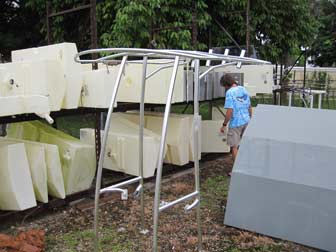
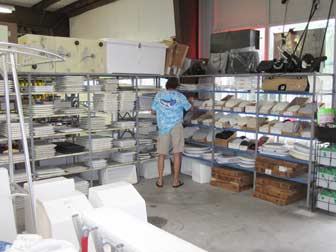
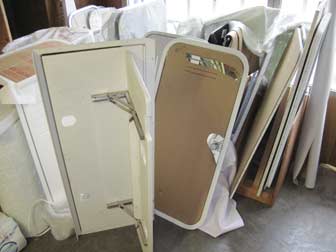
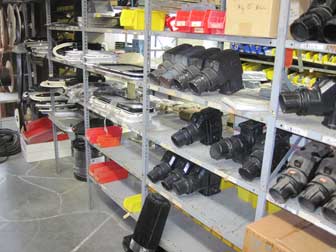
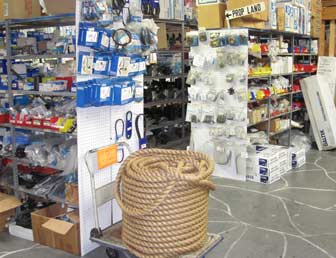
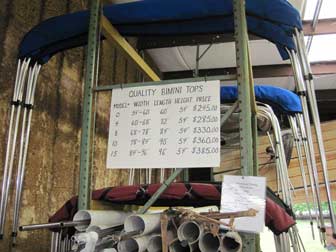
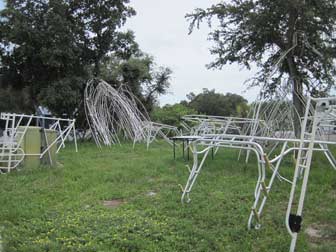
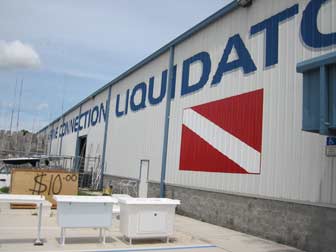
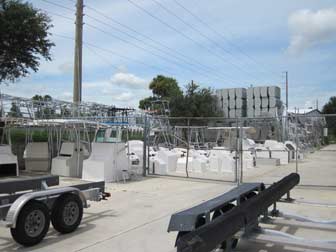
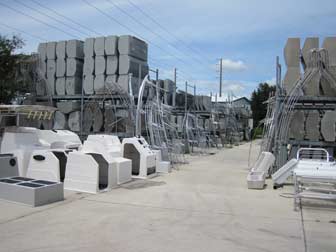
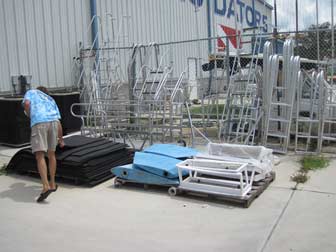
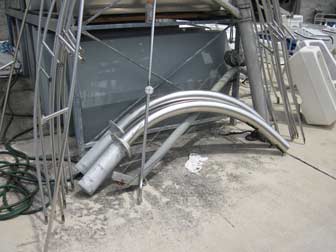
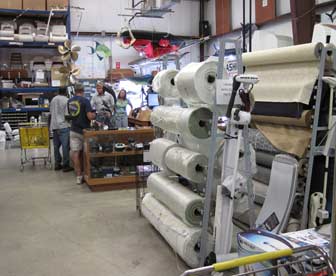
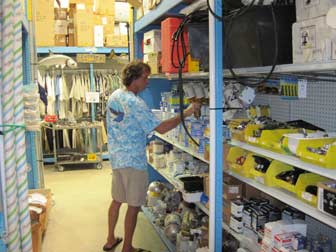
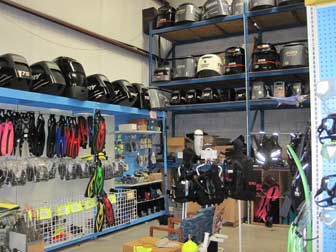
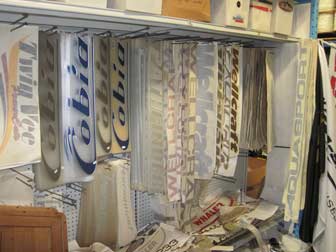
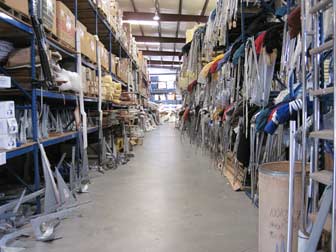
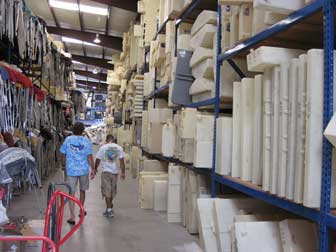
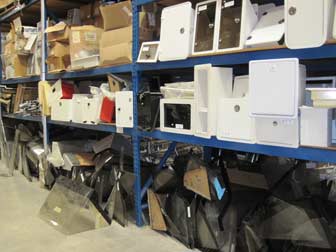
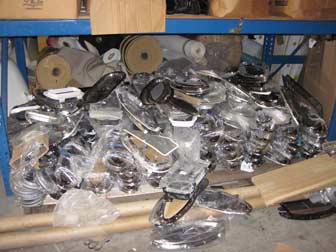
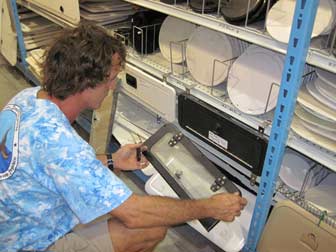
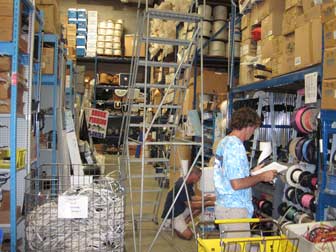
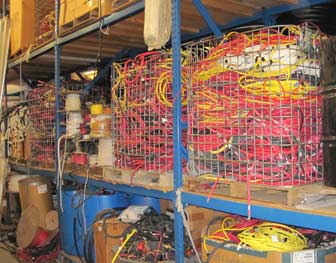
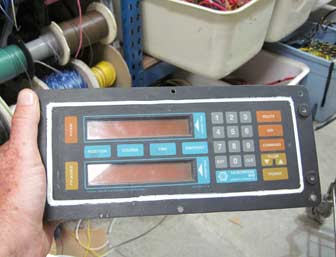
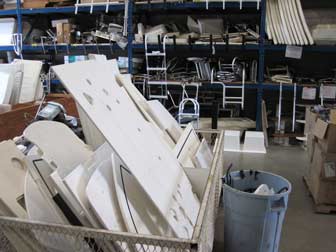
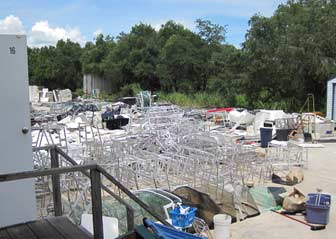
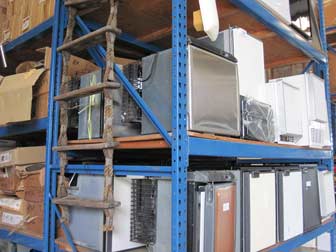
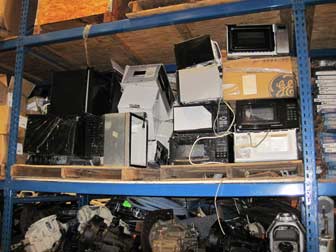
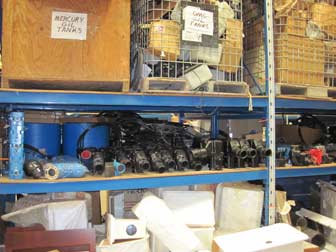
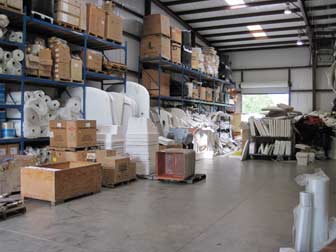
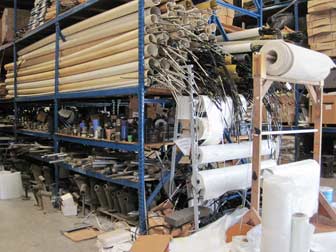
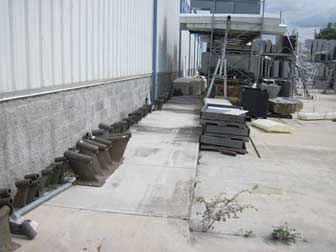
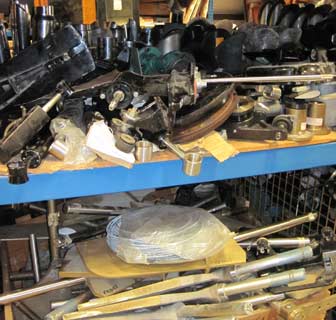
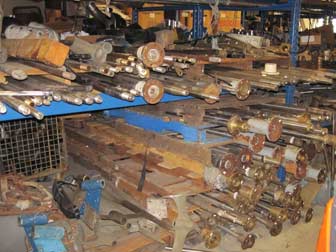
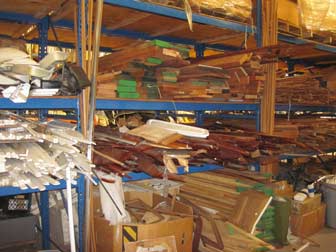
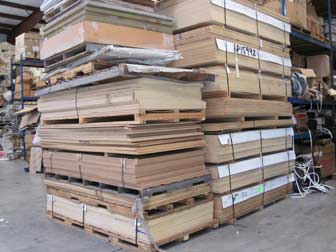
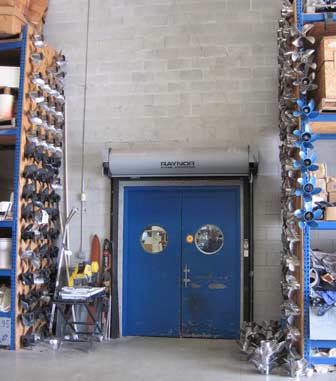
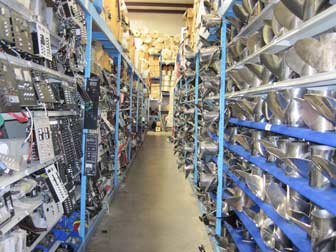
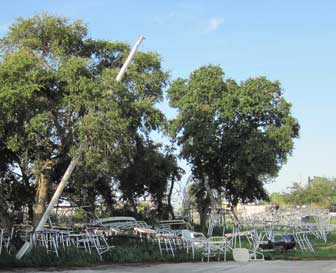
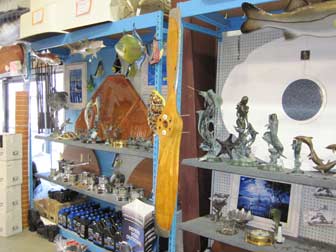
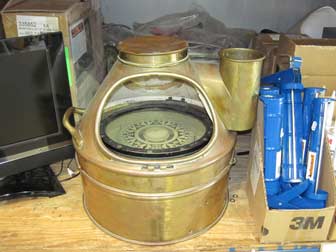
Leave a Reply
You must be logged in to post a comment.